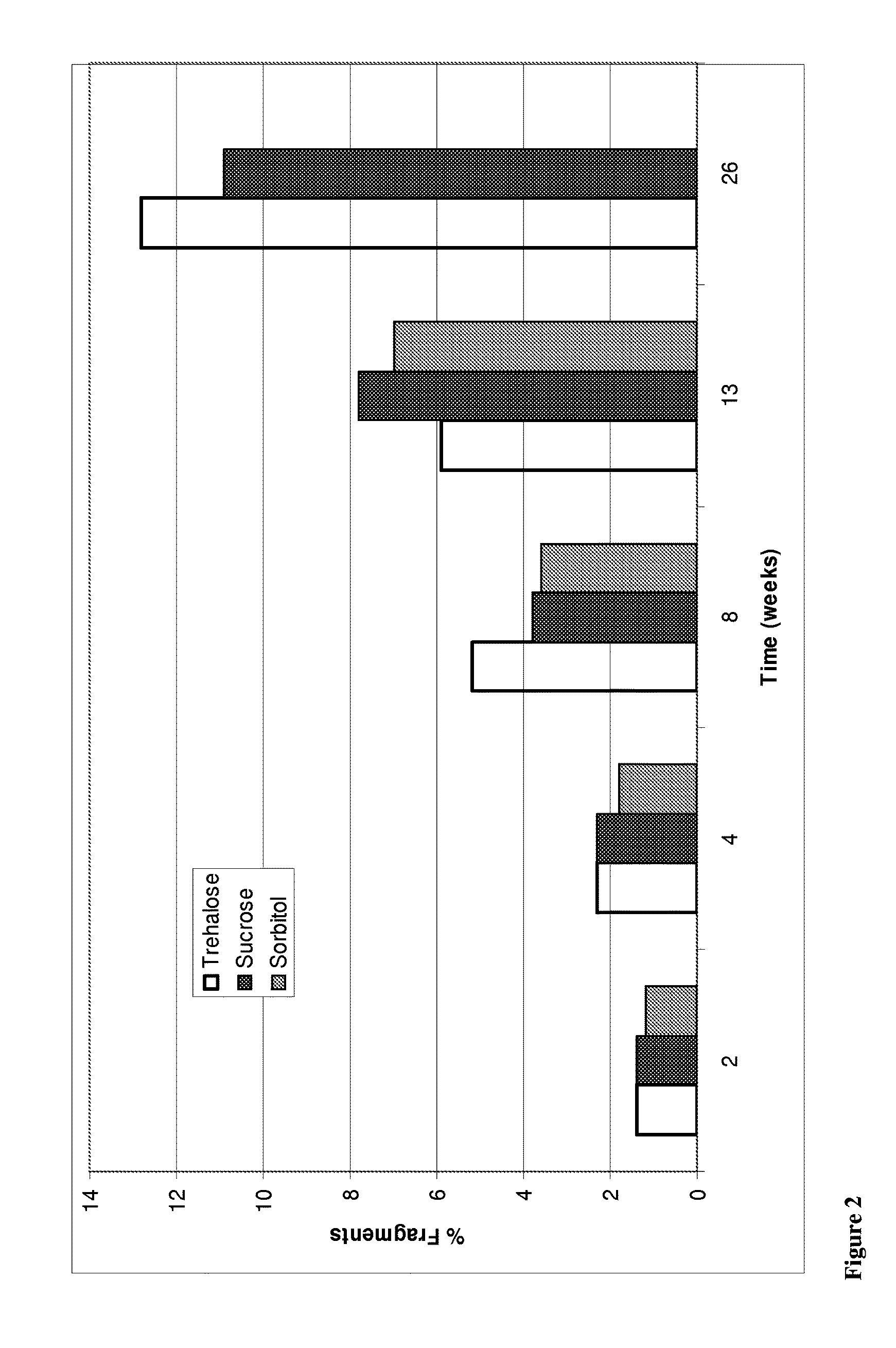Stable liquid antibody formulation
a liquid antibody and formulation technology, applied in the field of pharmaceutical formulations of antibodies, can solve the problems of exacerbated problems, pain and anaphylactoid side effects, and often occurs pain or injection, and achieve the effects of improving antibody stability, enhancing antibody stability and resistance to aggregation and fragmentation, and maintaining the stability of the antibody of the formulation
- Summary
- Abstract
- Description
- Claims
- Application Information
AI Technical Summary
Benefits of technology
Problems solved by technology
Method used
Image
Examples
example 1
Antibody Production and Purification
[0234]For expression of full antibodies, heavy and light chain variable regions were cloned in two mammalian expression vectors (Eb.911.E3 or Eb.pur.911.3E for light chain and Db.911.3E for heavy chain; described herein) and transfected using lipofectemine into HEK 293 cells for transient expression. Antibodies were purified using protein A using standard methods.
[0235]The generation, production, purification and characterization of the anti-NGF antibody E3 is described in the Examples of WO2004 / 058184, the entire content of which is herein incorporated by reference. Vectors incorporating E3 light chain and E3 heavy chain have been deposited with the American Type Culture Collection, 10801 University Boulevard, Manassas, Va., USA (ATCC):
ATCC AccessionDate ofMaterialNo.DepositEb.911.3EE3 light chainPTA-4893Jan. 8, 2003Eb.pur.911.3EE3 light chainPTA-4894Jan. 8, 2003Db.911.3EE3 heavy chainPTA-4895Jan. 8, 2003
[0236]Details concerning these deposits ca...
example 2
Analysis of Buffers and pH
[0245]A study was conducted to evaluate the effect of four different buffers on antibody aggregation and fragmentation.
[0246]Specifically, four liquid formulations comprising anti-NGF antibody E3 and buffered with acetate, succinate, histidine or Citrate were prepared. The formulations then were stored at 5, 25 and 40° C. and antibody aggregation, fragmentation and oxidation measurements were taken at 0, 4, 9 and 13 weeks.
[0247]The manufacturing process can be summarized as follows: The buffer is prepared, pH adjusted, and sterile filtered (see Table 2.1 and 2.2 for details). The antibody is concentrated then buffer exchanged. The antibody is analyzed with UV and then diluted with respective buffer to 20 mg / mL. The 20 mg / mL solution is then sterile filtered. Finally, the sterile solution is filled, stoppered and capped with an overseal.
Aggregation Analysis:
[0248]The antibody formulations of Table 2.2 were stored at a temperature of 5, 25 and 40° C. for 0, 4...
example 3
Analysis of Tonicity Agents
Trehalose Vs Sucrose Vs Sorbitol
[0255]A study was conducted to compare the effect of tonicity agents in particular trehalose, sucrose and sorbitol on stability of anti-NGF antibody E3 formulations. Specifically, three liquid formulations comprising anti-NGF antibody E3 and trehalose, sucrose or sorbitol were prepared as listed in Table 3.1. The formulations then were stored at 5, 25 and 40° C. and antibody aggregation, fragmentation and oxidation measurements were taken at 2, 4, 8, 13 and 26 weeks.
[0256]The manufacturing process for formulations in Table 3.1 can be summarized as follows: The buffer is prepared, pH adjusted, and sterile filtered (see Table 3.1 for details). Stock excipients solutions are prepared and sterile filtered. The antibody is concentrated then buffer exchanged. The concentrated antibody is analyzed with UV and then diluted with respective buffer to 50 mg / mL and respective excipients combined to the required concentration. The 50 mg / ...
PUM
| Property | Measurement | Unit |
|---|---|---|
| concentration | aaaaa | aaaaa |
| concentration | aaaaa | aaaaa |
| concentration | aaaaa | aaaaa |
Abstract
Description
Claims
Application Information
 Login to View More
Login to View More - R&D
- Intellectual Property
- Life Sciences
- Materials
- Tech Scout
- Unparalleled Data Quality
- Higher Quality Content
- 60% Fewer Hallucinations
Browse by: Latest US Patents, China's latest patents, Technical Efficacy Thesaurus, Application Domain, Technology Topic, Popular Technical Reports.
© 2025 PatSnap. All rights reserved.Legal|Privacy policy|Modern Slavery Act Transparency Statement|Sitemap|About US| Contact US: help@patsnap.com



